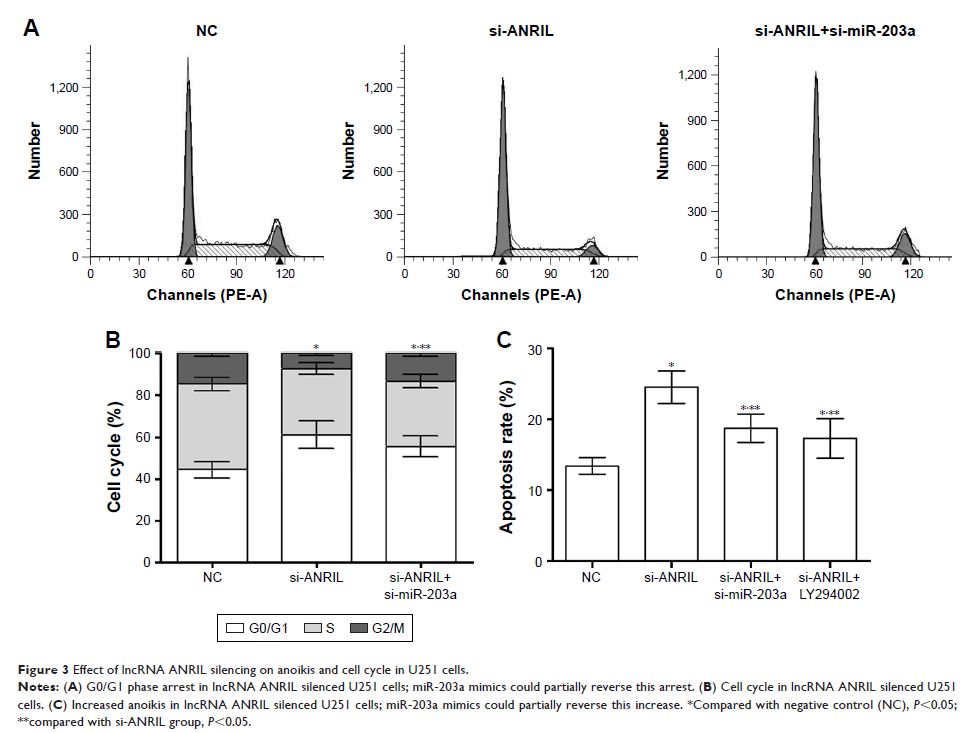108605
论文已发表
注册即可获取德孚的最新动态
IF 收录期刊
- 3.4 Breast Cancer (Dove Med Press)
- 3.2 Clin Epidemiol
- 2.6 Cancer Manag Res
- 2.9 Infect Drug Resist
- 3.7 Clin Interv Aging
- 5.1 Drug Des Dev Ther
- 3.1 Int J Chronic Obstr
- 6.6 Int J Nanomed
- 2.6 Int J Women's Health
- 2.9 Neuropsych Dis Treat
- 2.8 OncoTargets Ther
- 2.0 Patient Prefer Adher
- 2.2 Ther Clin Risk Manag
- 2.5 J Pain Res
- 3.0 Diabet Metab Synd Ob
- 3.2 Psychol Res Behav Ma
- 3.4 Nat Sci Sleep
- 1.8 Pharmgenomics Pers Med
- 2.0 Risk Manag Healthc Policy
- 4.1 J Inflamm Res
- 2.0 Int J Gen Med
- 3.4 J Hepatocell Carcinoma
- 3.0 J Asthma Allergy
- 2.2 Clin Cosmet Investig Dermatol
- 2.4 J Multidiscip Healthc

lncRNA ANRIL 沉默对 microRNA-203a 及人脑胶质瘤失巢凋亡及细胞周期的影响
Authors Dai W, Tian C, Jin S
Received 31 March 2018
Accepted for publication 1 June 2018
Published 23 August 2018 Volume 2018:11 Pages 5103—5109
DOI https://doi.org/10.2147/OTT.S169809
Checked for plagiarism Yes
Review by Single-blind
Peer reviewers approved by Dr Amy Norman
Peer reviewer comments 4
Editor who approved publication: Dr Samir Farghaly
Background: Glioma is a deadly nervous system tumor with a poor prognosis. Although there have been many efforts to overcome glioma, the molecular mechanism of its pathogenesis remains unclear.
Methods: We used human glioma U251 cells silenced for the oncogenic lncRNA ANRIL or overexpressing the anti-oncogene miR-203a to examine the role of lncRNA ANRIL silencing on anoikis and cell cycle arrest by flow cytometry. Meanwhile, the activity of caspase-3/8/9 was measured by fluorometric assay, the expression of tumor-related genes and activity of AKT signaling pathway was measured by Western blotting, real-time PCR, and dual luciferase reporter gene assay.
Results: lncRNA ANRIL was positively correlated with glioma grade and negatively correlated with miR-203a. lncRNA ANRIL silencing could induce anoikis and cell cycle arrest in G0/G1 phase, while regulating the activity of caspase-3/8/9 and the AKT signaling pathway, and the expression of tumor-related genes in the U251 cell line. miR-203a mimics could partially reverse these functions.
Conclusion: We consider that lncRNA ANRIL is a potential therapeutic and diagnostic target for glioma, and miR-203a plays an important role in the biological function of lncRNA ANRIL in glioma.
Keywords: glioma, long non-coding RNA, anoikis, cell cycle, lncRNA ANRIL, microRNA-203a
